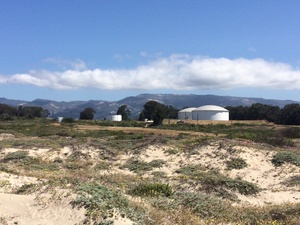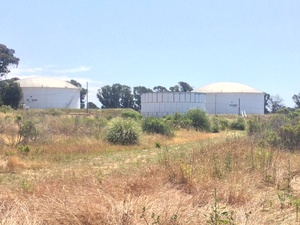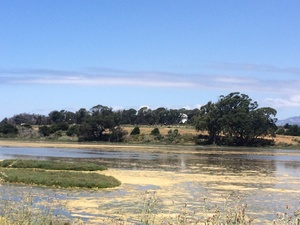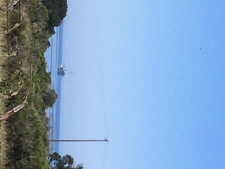Following Storke Road past FT, one will arrive at the North Campus Open Space, which is on its way from being a golf course to being redeveloped as it once was naturally. Along the only road, the Devereux Slough lays on the left, and the demolished golf course on the right. If you walk along the road for about a quarter of a mile, two gigantic oil tanks stick out like a sore thumb. This article explains the history of the oil tanks, including before oil development, and gives a peek into the tanks’ proposed future, although as we will see, oil companies have attempted to slow the process of removing the tanks at all steps of the way. In addition, although only under conditions of anonymity, we include a section of attitudes from locals regarding this process. Hopefully this article provides readers with a better understanding of how the UCSB landscape has changed, and will change, over time.
 View of Oil Tanks (right) from Sands Beach. Photo Credit: Evan Kroll.
View of Oil Tanks (right) from Sands Beach. Photo Credit: Evan Kroll.  Oil Tanks and Fire Water Storage from outside the complex. Photo Credit: Evan Kroll.
Oil Tanks and Fire Water Storage from outside the complex. Photo Credit: Evan Kroll.  View of the Tanks from Devereux Slough. Photo Credit: Evan Kroll.
View of the Tanks from Devereux Slough. Photo Credit: Evan Kroll.  Platform Holly from the Marine Terminal. Photo Credit: Evan Kroll.
Platform Holly from the Marine Terminal. Photo Credit: Evan Kroll.
Pre-Oil (1800s → 1966)
The land that the Oil Tanks sit on has a long history. It starts off with the Chumash settling here. Followed by the Spanish conquest from around 1567-1822. When they arrives, the Spanish took many Chumash as slaves, and left very few survivors. From 1822 to 1846, the land was granted to Nicholas Augustus Henry Den by the Mexican government, and he would name it Rancho Dos Pueblos. The end of the Mexican-American war would lead to California, and Rancho Dos Pueblos, property of the United States. The Den Family was still the owner of the land, and it wouldn’t be until the death of Nicholas that things started to go downhill for the family. The land was passed down to the children of Nicholas. They would not be allowed to sell the land until they were of appropriate age. Despite the conditions left in Nicholas’s will, the land was desperately sold to William Welles Hollister because a severe drought killed all of the Den family’s livestock. After Hollister had built multiple mansions and imported many exotic plants, Alfonso Den and some of his siblings hired lawyer Thomas B. Bishop to fight for the land that was sold by the Den children illegally. As payment, Bishop took part of the land which is today known as “The Bishop Ranch”. The rest of the land was split by the Den Brothers with a line Eucalyptus known as the “Eucalyptus Curtain”. The rest of the land was sold.
UCSB managed to take ownership of part of the land and would later lease to big companies like ARCO and Mobil. In 1947 they leased to Mobil, and in 1964 they leased another section of the land to ARCO. In 1966, the installation of Platform Holly would take place. This platform serves to extract all natural resources from under the land the the Platform is set upon.
|
Pre-Oil Infrastructure (1928). Photo Credit: UCSB Map and Imagery Lab. |
Ellwood Oilfield, Oil Tanks in bottom right (1939). Photo Credit: UCSB Map and Imagery Lab. |
|
Devereux Slough (1968). Photo Credit: UCSB Map and Imagery Lab. |
Platform Holly, Ellwood Onshore Facility, and Marine Terminal form a triangle when examined from above (1974). Photo Credit: UCSB Map and Imagery Lab. |
Oil Boom (1966 → 2000s)
As mentioned before, the first oil field leases were permitted in 1947, following World War II, however, the Ellwood Marine Terminal, which includes the oil tanks, was constructed in 1929 by the Burmah Oil Company. [1] Intensive development of the field did not occur until the 1960s. Following the installation of Platform Holly in 1966, the Ellwood Onshore Facility opened three years later, allowing for the low-quality oil and gas to be processed and refined. Oil drilled from the field under Platform Holly would be piped into the Ellwood Facility a couple miles Northwest of UCSB, and once processed, would be stored in the oil tanks west of Devereux. The tanks were connected via pipeline to a Marine Terminal in the tidewaters of Sand’s Beach. [2] Every ten days or so, oil barges would then dock up to these buoys, fill their tanks with oil, then move the oil to refineries throughout the coastline for further processing. [3] Throughout this time, environmental groups such as the Environmental Defense Center, protested the use of marine transport of oil, but saw little success in their efforts. [4]
In 1983, ARCO released the Marine Terminal, including the Devereaux tanks, but less than ten years later, the company quit-claimed the leases for fields 308 and 309, soon selling the leases to Mobil in 1993. Following Mobil’s acquisition of the oil fields, the company almost immediately proposed the Clearview Project, which would effectively remove Platform Holly, but promote horizontal drilling into the same field via on-shore sources. In a nutshell, although Platform Holly would not be visible in the water, Mobil would move all of its oil drilling power onto the shore, just a couple hundred feet from the ecological preserve that is the Devereux Slough. According to sources, Chancellor Yang, only being recently hired, enlisted the help of the faculty and staff to make his decision regarding this project. After a campaign from staff from all departments throughout the school, Chancellor Yang announced that he would not accept the billion dollar proposal.[5]
Two years after its defeat, Mobil dropped the Clearview Project and eventually sold its lease of the oil fields to Venoco, Inc. During this process, environmental groups once again pressed for a pipeline to be developed to phase out marine transport of the oil-- not only was an oil spill a concern, greenhouse gas emissions, as well as destruction to wildlife also factored into this request. [6] However, Venoco denied their requests, and continued to pump oil into barges via the Marine Terminal.[7] However, in aim to avoid the leakage of further fugitive gas emissions and the risk of a possible oil spill, the State Lands Commission created regulations that required double hold barges for the transportation of oil from the drums to the refinery facilities. In response to this, Venoco finally built the 8.5 mile oil pipeline to connect to the already existing Plains All-American Pipeline near Las Flores Canyon that environmental groups had been asking for. [8] Despite this progress, the Marine Terminal was shut down in 2012 [9] and Platform Holly decommissioned in 2015 after Plains All American Pipeline spilled more than 120,000 gallons of crude into the ocean. [10] The Refugio Oil Spill devastated the natural environment and cost the county an estimated $74 million dollars in damages.
Future Restoration
In 2016 the lease for the oil storage tanks expired, returning the property to open space owned by UCSB. Venoco was required to create a decommissioning plan to remove the tanks and completely remediate and restore the EMT area by 2016. Venoco failed to do so. An involved UCSB professor disclosed that there is currently an environmental review process undergoing for the offshore and onshore marine terminal and a draft Mitigated Negative Declaration (MND) is almost completed. This will now be Venoco’s plan for decommissioning, with increased mitigations. The plan was almost released to the public for review when Venoco declared bankruptcy. Now the State Lands Commission (SLC) must deal with the offshore portion of the operation, and University is collaborating with the SLC to keep the decommissioning process moving forward. Venoco is also abandoning operations at platform Holly, the Ellwood onshore facility and multiple piers. A recent report from the State Lands Commission states “Venoco's notification and subsequent quitclaim effectively end commercial oil and gas production within state waters in the Santa Barbara Channel at this location, leaving approximately 85.1 million barrels of recoverable oil in the ground. The Coastal Sanctuary Act prohibits the Commission from issuing new offshore oil and gas leases, except under very limited circumstances, none of which currently exist at this location.” [11] This, for the time being, is good news for Santa Barbara and the ecologically sensitive areas in which oil has been historically and systematically extracted and contained. California is leading the shift away from energy produced from petroleum and heading towards more sustainable solutions, even in the wake of the United States elected pro-oil President, Donald Trump.
The area involved in the efforts for restoration is the Venoco Ellwood Marine Terminal, just 0.75 miles northwest of Coal Oil Point and west of the Devereux Slough. Coal Oil Point is part of the UC Natural Reserves System and the dunes provide a natural habitat for the threatened Snowy Plover [12] and Devereux Slough provides an estuary for many bird species. The EMT Lease site is about 18 -acres in totality, located on a knoll perched above the tidal wetlands and floodplains of the Devereux Slough. After a revision of UCSB’s Long Range Development Plan (LRDP), the university agreed not to develop south of the golf course, South Parcel, where the oil storage tanks are in the ecologically sensitive area.[13] The LRDP policies also require “the removal and restoration of the Ellwood Marine Terminal by 2016 and restoration of the South Parcel as a nature park.”[14] Policy ESH-46 of the UCSB 2010 LRDP pertains to the removal of the EMT Facilities and subsequent habitat restoration.[15] Also included in the 2010 LRDP is that the Ellwood Marine Terminal Facility has a known contamination risk and shall be subject to Policy ESH- 50. [16]
A preliminary Restoration and Monitoring plan (R&M) for the EMT Decommissioning from the County of Santa Barbara proposes recommendations based on the findings of a Biological Assessment of the area. Such factors include the potential impacts resulting from the demolition of the EMT facilities and the recontouring of the site as closely as possible to the previous “natural” conditions. The Draft Environmental Impact Report (DEIR) for the Ellwood Pipeline Company Line 96 Modification Project stipulates the need for demolition and reclamation of the EMT site to a “natural condition consistent with surrounding properties." [17] This R&M plan is designed to allow the transfer of the EMT site to UCSB in a condition comparable to the surrounding lands, to recreate and revegetate with local, native plant species, remove invasive species and preserve wetlands. The project plan is in collaboration between CCBER and Coal Oil Point Reserve (COPR). It is then proposed that Venoco will work with UCSB to monitor the site for five years to ensure the success of the restoration effort. Key factors of the monitoring process will note species diversity, estimations of ground cover of vegetation, vegetative cover of dominant species, wildlife usage, hydrology, etc. A restoration ecologist must be present during the monitoring process and grading phase.
Attitudes [18]
According to a local authority on the issue, residents are excited to see the land where these oil tanks are be restored back into a coastal habitat. Another local stated that coastal habitats are rare, so the chance to restore them is an extremely exciting opportunity. While it is debateable whether or not artificial reefs from oil rigs are less harmful to the aquatic ecosystems than completely removing them, members of the Environmental Defense Center, and other groups, believe that they cause more harm than benefit.
An interesting safety issue that occurred within the last couple of decades is that the lid of the oil tank actually collapsed into itself. This caused rancid smells to encompass UCSB. While the sight of the tanks could be forgotten since they are located away from residential areas, the smell in the air was a constant reminder of what lies on this coastal landscape so close to home. The general consensus of restoring the area back to its natural landscape is overwhelming positive. Many believe that this is a step in the right direction, however, the final product of the restoration is yet to occur, so unforeseen problems may arise.
Footnotes
1. http://www.sbcountyplanning.org/energy/projects/venoco.asp
2. https://www.ourair.org/venoco-ellwood/
3. Environmental Defense Center Interview.
4. Environmental Defense Center Interview.
5. Environmental Defense Center Interview.
6. Personal Interview with Expert on Topic.
7. Environmental Defense Center Interview.
8. "New pipeline to end Ellwood Marine Terminal operation." Tank Storage Magazine. N.p., 18 May 2009. Web. 04 June 2017.
9. "Ellwood Marine Terminal Decommissioning." City of Goleta. N.p., n.d. Web. 04 June 2017.
10. Associated Press. "Venoco seeks bankruptcy protection after losses from huge 2015 oil spill near Santa Barbara." Los Angeles Times. N.p., 07 Apr. 2017. Web. 04 June 2017.
11. Fact Sheet: South Ellwood Field Lease Quitclaims. California State Lands Commission. N.p., 2017. Web. <http://www.slc.ca.gov/About/News_Room/2017/04-17-17FS.pdfhttp://www.slc.ca.gov/About/News_Room/2017/04-17-17FS.pdf>.
12. Leachman, Shelly. "Protecting the Plover." The UCSB Current. UCSB, 27 May 2015. Web. 04 June 2017.
13. 2010 UC Santa Barbara Long Range Development Plan. Rep. Santa Barbara: UCSB, 2010. Print. Page B-12
14. 2010 UC Santa Barbara Long Range Development Plan. Rep. Santa Barbara: UCSB, 2010. Print. Page F-14
15. Policy ESH-46
16. Policy ESH-50
17. County of Santa Barbara. Draft environmental impact report for the Ellwood Pipeline Company line 96 modification project. Santa Barbara, CA: Venoco Inc., 2011. Sbcountyplanning.org. Web. <County of Santa Barbara. Draft environmental impact report for the Ellwood Pipeline Company line 96 modification project. Santa Barbara, CA: Venoco Inc., 2011. Web. .>.
18. Personal Interviews with local authorities/ experts/ residents.



